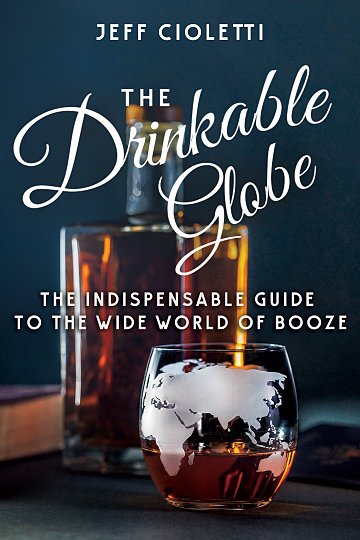The Drinkable Globe
- By Jeff Cioletti
- Turner
- 416 pp.
- Reviewed by Garrett Peck
- January 20, 2019
An intoxicating, culture-by-culture imbibing tour.

“Booze tourism” is the focus of Jeff Cioletti’s conversational travelogue, The Drinkable Globe. Over the past several years, the author traveled the world and catalogued the drinking culture of most nations. That’s an impressive achievement in itself. And now he’s given us valuable insights into his booze-fueled adventures.
“I think travel will become the new religion,” Cioletti learned from a driver in Argentina. “People will see how alike everyone really is,” even if what they choose to drink varies from country to country.
The author has organized the book regionally, beginning with Australia and New Zealand, then heading west to Asia, Africa, Europe, South America, and finally ending with the United States. You can easily read the book like an encyclopedia, skimming around to countries you plan to visit.
Going to Italy? You should absolutely enjoy the Italian version of happy hour with amaro-based drinks and small plates of food. Traveling to Poland or Russia? Don’t skip the vodka.
Cioletti’s advice: Drink whatever the locals are having. Many countries have developed distinct drinking cultures over the centuries that visitors can enjoy. Like going to McDonald’s in Rome instead of a trattoria, it would be a shame to miss out on local culture.
The Drinkable Globe is written conversationally, as if you’re sitting at a bar with Cioletti, nursing a good whiskey and listening to his quick wit. Though the author is a self-professed beer lover, his book addresses distilled spirits more so than brews or wine.
In fact, the American chapter is neatly (pun intended) focused entirely on bourbon and rye whiskey. He brings an approachable, regular Joe attitude about drinking: “I really don’t believe there’s any wrong way to drink anything, as long as you’re enjoying it.”
The book serves as a bar manual, as well: Cioletti has gathered recipes from bartenders around the world. Most countries featured have a corresponding cocktail section highlighting local ingredients.
The challenge to the reader is that many of these recipes are complex and require esoteric ingredients specific to a country but hard to find at your supermarket. This complexity tests the at-home imbiber, as you may not have many of the liquors or special syrups. (I do like many of his suggestions, though, such as soaking an onion in vodka.)
Cioletti points out misconceptions that cloud how we view other liquor-producing countries: “The Spanish love their sherry, the French love their Cognac, and the Portuguese love their port…But most of its consumption happens everywhere but in its home country.”
While exports of these liquors are major economic drivers, local populations often choose to drink something else. The French, for example, rarely touch Cognac but drink Armagnac instead, which is rarely exported.
Modern American drinking habits are largely European in origin, and Europe garners the largest coverage in the book. The United Kingdom, including Scotland, is covered in 19 pages, while China gets just under three. The Middle East is similarly glossed over, but that’s for good reason: Many countries there don’t allow drinking at all.
For as much as the author loves beer, he gives the world’s favorite alcoholic beverage short shrift by writing mostly about spirits. He discusses how he fell in love with beer in Belgium, and though he provides a nice history of alcohol in the Low Countries, he foregoes how dynamic and experimental Belgian brewing has become. He mentions Iceland’s thriving beer scene in just one sentence, instead focusing on brennivin, an Icelandic brandy.
Amid all the descriptions of distilled spirits, I kept wanting to ask, “But what about the country’s beer culture?” Beer is still largely what people drink. Cioletti does confirm how predominant lager has become worldwide, thanks to multinational corporations that rose up in the wake of global empires.
Because of globalization, drinking is becoming ever-more standardized. The author is suitably circumspect: “At times I’m thrilled that better, thoughtful drinking is an international phenomenon; at others, I’m a tad mournful that worldwide imbibing marches slowly but steadily toward homogenization.”
Does the book make you want to travel more to drink? Perhaps. Despite the premise, it’s not really a travel guide, but rather an overview of spirits and local drinking culture and etiquette. You’ll learn about liquors you may not have heard of before: arak in the Middle East; fermented horse’s milk in Mongolia; palm wine in Senegal; rakia in the former Yugoslavia; singani in Bolivia.
“Even if you don’t leave your own city, you can still allow yourself to be transported,” Cioletti explains.
Does The Drinkable Globe provide insight into what’s in your preferred tipple? Absolutely. Cioletti’s book is proof that you don’t need to travel the world to find a good drink. There’s one waiting in your glass.
[Editor's note: This review originally ran in 2018.]
Garrett Peck is the author of six books, most recently Capital Beer: A Heady History of Brewing in Washington, D.C., and also The Prohibition Hangover: Alcohol in America from Demon Rum to Cult Cabernet and Prohibition in Washington, D.C.: How Dry We Weren’t. He leads tours in the nation’s capital and is publishing his seventh book, The Great War in America: World War I and Its Aftermath, in fall 2018.

